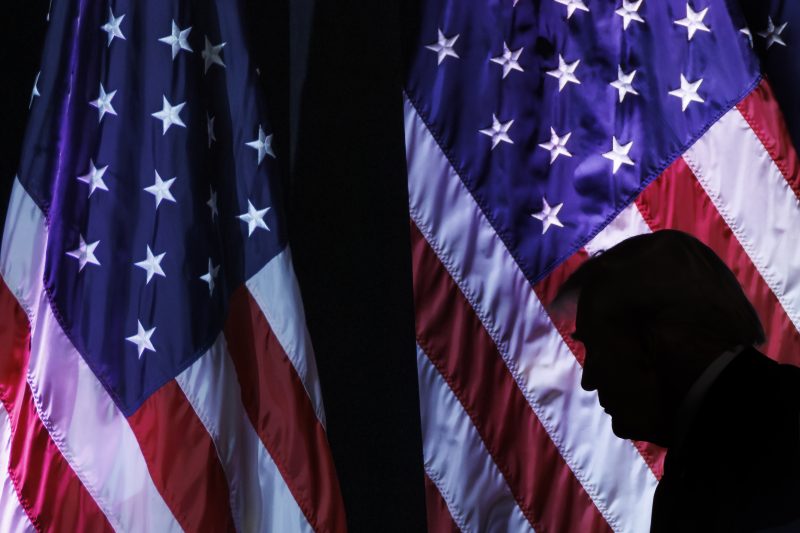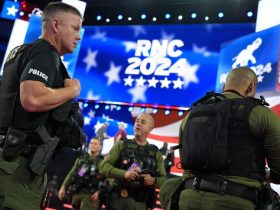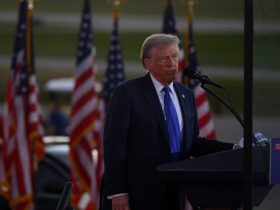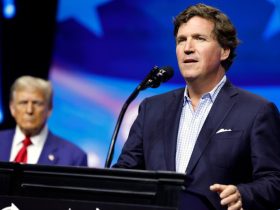The first person who I noticed spreading the idea that images of Vice President Kamala Harris’s rally in Michigan had been manipulated was conservative moviemaker Dinesh D’Souza.
On Saturday evening, D’Souza posted a photo on social media of Harris exiting her airplane with a crowd of supporters looking on. Two reflections from the airplane were circled in red, illustrating that, despite the crowd, no one was visible in the reflection.
“Does this look like a real picture to you?” D’Souza asked. Within hours, similar questions were everywhere on social media — and by Sunday had popped up in former president Donald Trump’s feed at Truth Social.
“Has anyone noticed that Kamala CHEATED at the airport? There was nobody at the plane, and she ‘A.I.’d’ it, and showed a massive ‘crowd’ of so-called followers, BUT THEY DIDN’T EXIST!” Trump wrote. “She was turned in by a maintenance worker at the airport when he noticed the fake crowd picture, but there was nobody there, later confirmed by the reflection of the mirror like finish on the Vice Presidential Plane.”
“She’s a CHEATER,” he reiterated.
That D’Souza was at the leading edge of this argument is not surprising. It was D’Souza, you may recall, who produced a feature-length movie arguing without evidence that the 2020 election had been stolen by “mules” who collected and submitted ballots on behalf of Joe Biden. Then, as now, D’Souza’s claims were rooted in a trivial misrepresentation of digital information.
There was a crowd in Michigan to meet Harris, as shown below in a photograph taken by a Washington Post photographer. You can also see why the reflection from the plane didn’t show the crowd; it was angled away from the speaking platform.
No AI. No whistleblowing maintenance worker, ginned up from the ether to make the claim of dishonesty seem more credible. And no “cheating” by Harris.
Why would Trump and his allies spread a false claim about attendance at a rally that was covered on C-SPAN? In part because many elements of Trump’s base have embraced rejections of basic reality (like the existence of “mules”) for years. In part, it’s confirmation bias, with partisans being more likely to accept false information as true when it supports their preexisting beliefs. But in part, it’s because Trump and his allies are already eagerly raising questions about the reliability of measures of Harris’s support — and by extension, the reliability of the results in November.
Harris is a CHEATER, Trump asserts. It is not subtle.
Recall that his efforts to reject the 2020 results did not emerge out of the blue in November of that year. Trump began raising questions about the purported insecurity of mail-in ballots soon after it became obvious that the coronavirus pandemic would spur more remote voting. He and his staff amplified all sorts of claims about ballot security, including a bizarre claim that July that a mail truck that caught fire was somehow suspicious. His base was more than prepared when he subsequently challenged the actual election results.
That’s the pattern that is again underway, exemplified well beyond this one goofy assertion about the Michigan rally. In reporting its lengthy assessment of Trump’s recent campaign stumbles, the New York Times spoke with someone close to Trump who described the former president’s framing of Harris’s ascent to be her party’s nominee.
“Mr. Trump told one aide,” Maggie Haberman and Jonathan Swan reported, “that Democrats were trying to ‘steal’ the election again from him — comparing the reshuffling of the Democratic ticket to when state legislatures changed voting rules midway through the 2020 election cycle because of the Covid pandemic.”
States making it easier for people to vote without risking coronavirus infections in 2020 was not cheating in any way that doesn’t assume that ensuring voters can vote is somehow unfair. Nor is a political party choosing its own nominee. But it is important to Trump that he keep this escape hatch open, this idea that the election was or will be stolen from him even in the most abstract terms, because it allows him to muster resources to contest his loss or, alternatively, to retain the loyalty of his base.
A loss this November looks more possible than it did a month ago, certainly. Over the weekend, the New York Times released new swing-state polling showing Harris with leads across the Upper Midwest. So, naturally, Trump’s campaign released a memo suggesting that the polling was fake or misleading.
The results, pollster Tony Fabrizio and data consultant Tim Saler argue, “dramatically understated President Trump’s support both among all registered voters and in their likely-voter model.” Their evidence for this is that the recalled vote of respondents — that is, people saying how they voted in 2020 — understates the actual support Trump saw in those states four years ago.
As Fabrizio certainly knows, though, voter recall is unreliable. People tend to misremember or misreport how they actually voted, with a shift in favor of the electoral winner. In fact, there’s been research showing that using recalled votes to adjust current polls is fraught. But that’s what Fabrizio and Saler do.
“In each state, the gap between the survey’s recalled 2020 vote and the reported 2020 election results is more than the margin between Kamala Harris and President Trump,” they write. “Once again, we see a series of public surveys released with the clear intent and purpose of depressing support for President Trump.”
That last argument is particularly silly. The idea — one Trump himself offered repeatedly in 2020 — is that polls showing Trump trailing somehow make Trump supporters less likely to support Trump. It’s not clear how this manifests; is the argument that those voters will consider casting a ballot in November until they remember the Times’s August poll?
The simple answer is that this unskewing of the poll (to revive an infamous 2012 phrase) is simply meant to suggest that no measure of reality can be trusted unless it favors Trump. The results in those states might not reflect this poll, certainly, but the argument that the results were skewed against Trump to damage him in some esoteric way is ridiculous. Almost as ridiculous as claiming that an unnamed worker at an airport is more reliable than multiple photos and live video.
But the point isn’t to increase Trump’s credibility. It’s to erode everyone else’s. That way, when they accurately report the results in November, Trump can remind his supporters to reject them if necessary.










